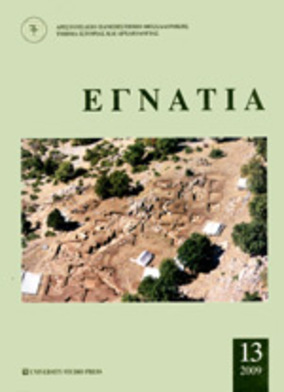Η ανάγλυφη διακόσμηση των ελληνιστικών πυξίδων : τα μετάλλια
Part of : Εγνατία ; No.15, 2011, pages 209-217
Issue:
Pages:
209-217
Parallel Title:
Embossed decoration on hellenistic pyxide : the medallions
Section Title:
Αρχαιολογία
Author:
Abstract:
A very interesting topic in the study of Hellenistic pottery are the embossed stamps decoratingthe top ofthe lids of hellenistic pyxides. Several questions arise from the examinationofthe till today known excavation examples. The origins ofthis decorative pattern, the reasonsfor applying it to the specific vessel-shape, the formation of a stable chronological framefor pyxides with medallions and their “identification” as products oflocal workshops, are themost important ofthese questions.The medallion appears for the first time, on dome ofthe pyxides’ lids, at the end ofthe4th century B.C. and the beginning ofthe 3rd century B.C., initially to type A pyxides andthen at the end ofthe 3rd century or at the beginning ofthe 2nd century B.C. to those oftypeB. Adding this decorative item to pyxides is probably an inspiration coming from the Macedonianspotters. Clay matrixes were used for the manufacturing ofthe clay medallions. Theirdiameter is 0,06-0,08 m. To a pyxis’ lid from Leukadia the diameter ofthe medallion reaches0,10 m. The figures on these circular emblems are usually busts offemale deities, dionysiacfigures and the head of Medusa. Rare are the scenes with many figures and the busts ofmaledeities and heroes. Around these figures embossed rings and other decoration are developing.There also some known examples (from Véroia, Pella, and Edessa) on which the figuresofthe medallions apply on the pyxides’ lids without the embossed frame.A comparative study between medallions offers very interesting conclusions for the manufacturingand development ofthese decorative patterns. In few cases (especially in examplescoming from Macedonia) it is obvious that the same matrix has been used for the manufacturingofmore than one medallion, in different pyxides’ lids and in different types of pyxidestoo. The characteristics offigures on medallions indicate also the products coming from thesame local workshop and point out to the similarities between medallions and other circular,or not, emblems commonly used throughout the hellenistic period.From the known examples of pyxides with medallions it is obvious that the potters fromother regions than Macedonia have been influenced in the manufacturing ofthese vesselsfrom the Macedonian potters. The medallions coming from i.e. Crete or Corinth commit toearly forms ofthese emblems. The two earlier pyxides with medallion come probably fromMacedonia and are placed to the first or second quarter ofthe 3rd century B.C. according toZ. Kotitsa.Various theories have been developed over the years about the ‘precursors’ ofmedallions.Undeniable remains however the significant impact ofmetalworking, which has been provedby the appearance ofthe one known gilded medallion on a silver pyxis from Amphipolis (alsoon a recently found brazen kalpis-pyxis from Pelinnaion). Interesting is also the use of othermaterials, as silver, covering the medallion and other parts of clay pyxides.Generally the medallion has been an independent decorative element with multiple applications.Its appearance on the lids of clay pyxides seems to be part of an effort made inthose times for transition from metal prototypes to cheapest materials as clay. Potters ‘shaped’the illusion of a decline —for the time being- luxuriance by coping patterns commonly usedin metalworking. The production of clay pyxides with medallion ends at the end ofthe 2nd or early 1st century B.C. There is no clear indication on the continuation ofthis production during the imperial period.
Subject:
Subject (LC):
Keywords:
κεραμική
Notes:
Περιέχει εικόνες




